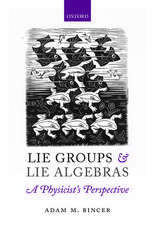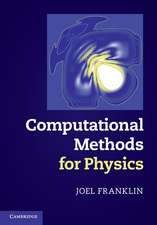Computational Methods in Bifurcation Theory and Dissipative Structures: Scientific Computation
Autor M. Kubicek, M. Mareken Limba Engleză Paperback – 9 apr 2012
Din seria Scientific Computation
- 18%
 Preț: 1021.05 lei
Preț: 1021.05 lei - 18%
 Preț: 743.27 lei
Preț: 743.27 lei - 18%
 Preț: 889.75 lei
Preț: 889.75 lei - 18%
 Preț: 1108.51 lei
Preț: 1108.51 lei -
 Preț: 387.96 lei
Preț: 387.96 lei - 20%
 Preț: 902.04 lei
Preț: 902.04 lei -
 Preț: 400.85 lei
Preț: 400.85 lei -
 Preț: 386.61 lei
Preț: 386.61 lei - 15%
 Preț: 654.62 lei
Preț: 654.62 lei -
 Preț: 380.25 lei
Preț: 380.25 lei - 18%
 Preț: 1111.34 lei
Preț: 1111.34 lei -
 Preț: 452.62 lei
Preț: 452.62 lei -
 Preț: 389.31 lei
Preț: 389.31 lei - 18%
 Preț: 950.03 lei
Preț: 950.03 lei - 15%
 Preț: 649.22 lei
Preț: 649.22 lei - 18%
 Preț: 787.26 lei
Preț: 787.26 lei - 18%
 Preț: 942.63 lei
Preț: 942.63 lei - 15%
 Preț: 505.18 lei
Preț: 505.18 lei -
 Preț: 389.70 lei
Preț: 389.70 lei - 15%
 Preț: 653.00 lei
Preț: 653.00 lei - 18%
 Preț: 957.44 lei
Preț: 957.44 lei - 15%
 Preț: 653.98 lei
Preț: 653.98 lei - 15%
 Preț: 643.99 lei
Preț: 643.99 lei - 15%
 Preț: 649.39 lei
Preț: 649.39 lei -
 Preț: 388.13 lei
Preț: 388.13 lei - 18%
 Preț: 958.38 lei
Preț: 958.38 lei - 18%
 Preț: 1129.52 lei
Preț: 1129.52 lei - 18%
 Preț: 967.56 lei
Preț: 967.56 lei - 15%
 Preț: 700.75 lei
Preț: 700.75 lei -
 Preț: 401.03 lei
Preț: 401.03 lei - 15%
 Preț: 597.99 lei
Preț: 597.99 lei -
 Preț: 385.62 lei
Preț: 385.62 lei -
 Preț: 394.87 lei
Preț: 394.87 lei -
 Preț: 385.08 lei
Preț: 385.08 lei - 18%
 Preț: 1106.63 lei
Preț: 1106.63 lei - 15%
 Preț: 504.17 lei
Preț: 504.17 lei - 15%
 Preț: 596.36 lei
Preț: 596.36 lei - 15%
 Preț: 653.98 lei
Preț: 653.98 lei
Preț: 386.00 lei
Nou
Puncte Express: 579
Preț estimativ în valută:
73.87€ • 80.21$ • 62.05£
73.87€ • 80.21$ • 62.05£
Carte tipărită la comandă
Livrare economică 22 aprilie-06 mai
Preluare comenzi: 021 569.72.76
Specificații
ISBN-13: 9783642859595
ISBN-10: 3642859593
Pagini: 260
Ilustrații: XII, 243 p.
Dimensiuni: 155 x 235 x 14 mm
Greutate: 0.37 kg
Ediția:Softcover reprint of the original 1st ed. 1983
Editura: Springer Berlin, Heidelberg
Colecția Springer
Seria Scientific Computation
Locul publicării:Berlin, Heidelberg, Germany
ISBN-10: 3642859593
Pagini: 260
Ilustrații: XII, 243 p.
Dimensiuni: 155 x 235 x 14 mm
Greutate: 0.37 kg
Ediția:Softcover reprint of the original 1st ed. 1983
Editura: Springer Berlin, Heidelberg
Colecția Springer
Seria Scientific Computation
Locul publicării:Berlin, Heidelberg, Germany
Public țintă
ResearchCuprins
1. Introduction.- 1.1 General Introduction.- 1.2 Dissipative Structures in Physical, Chemical, and Biological Systems.- 1.3 Basic Concepts and Properties of Nonlinear Systems.- 1.4 Examples.- 2. Multiplicity and Stability in Lumped-Parameter Systems (LPS).- 2.1 Steady-State Solutions.- 2.2 Dependence of Steady-State Solutions on a Parameter—Solution Diagram.- 2.3 Stability of Steady-State Solutions.- 2.4 Branch Points—Real Bifurcation.- 2.5 Branch Points—Complex Bifurcations.- 2.6 Bifurcation Diagram.- 2.7 Transient Behavior of LPS—Numerical Methods.- 2.8 Computation of Periodic Solutions.- 2.9 Chaotic Attractors.- 3. Multiplicity and Stability in Distributed-Parameter Systems (DPS).- 3.1 Steady-State Solutions—Methods for Solving Nonlinear Boundary-Value Problems.- 3.2 Dependence of Steady-State Solutions on a Parameter.- 3.3 Branch Points—Methods for Evaluating Real and Complex Bifurcation Points.- 3.4 Methods for Transient Simulation of Parabolic Equations—Finite-Difference Methods.- 4. Development of Quasi-stationary Patterns with Changing Parameter.- 4.1 Quasi-stationary Behavior in LPS—Examples.- 4.2 Quasi-stationary Behavior in DPS—Examples.- 5. Perspectives.- Appendix A DERPAR—A Continuation Algorithm.- Appendix B SHOOT—An Algorithm for Solving Nonlinear Boundary-Value Problems by the Shooting Method.- Appendix C Bifurcation and Stability Theory.- C. 1 Invariant Manifolds and the Center-Manifold Theorem (Reduction of Dimension).- C.2 Normal Forms.- C.3 Bifurcation of Singular Points of Vector Fields.- C.4 Codimension of a Vector Field. Unfolding of a Vector Field.- C.5 Construction of a Versal Deformation.- C.6 Bifurcations of Codimension 2.- C.7 Bifurcations from Limit Cycles.- References.














